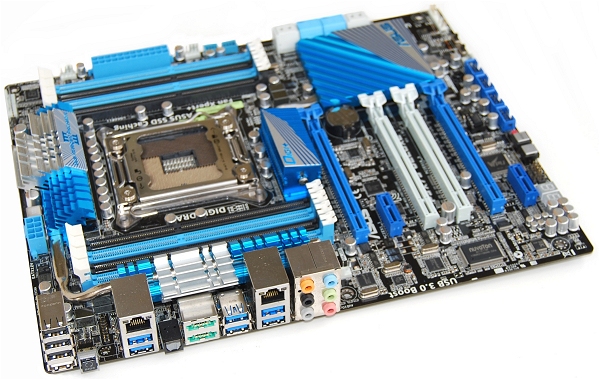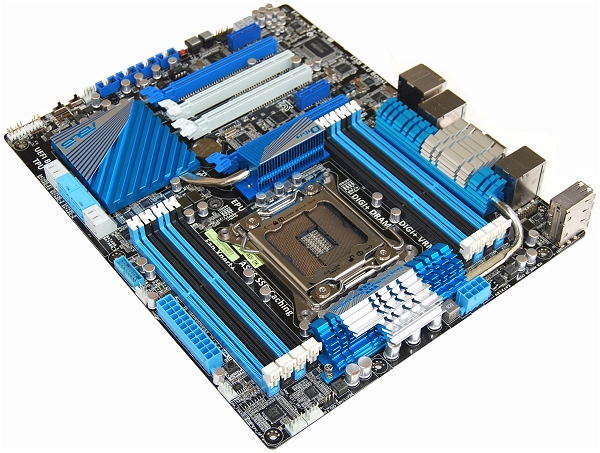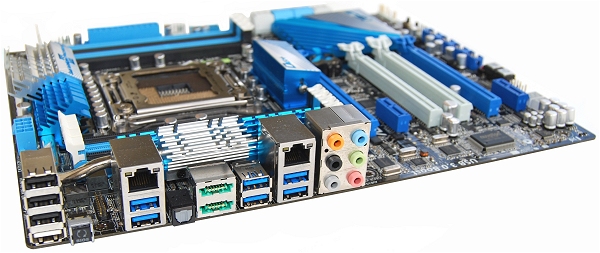Asus P9X79 Deluxe
The priciest motherboard in our roundup, the Asus P9X79 Deluxe seems like a good place to start, as it should set the bar for all other X79 boards.

The P9X79 Deluxe has extensive multi-GPU support, including 3-way SLI and 4-way CrossfireX. There are four PCI Express 3.0 x16 slots, though only three of them are really usable. The second and third slots are placed adjacent to each other, making the third slot too cramped for dual-slot cards. With three cards, the board provides full x16 bandwidth to the primary and secondary GPUs, while the third is limited to x8.

The board packs eight DIMM slots for a max. memory configuration of 64GB. The board supports memory frequencies of 1866, 1600, 1333 and 1066MHz while 2400 and 2133MHz are possible via overclocking.

Asus has improved its board's storage capabilities by expanding on X79's two 6Gb/s SATA and four 3Gb/s SATA ports. The Marvell 88SE9128 controller has been used to provide two more 6GB/s SATA ports (color-coded white). The ASMedia ASM1061 controller is also used to provide two eSATA 6Gb/s ports (colored green) on the board's I/O panel.
Asus has network connectivity well covered with dual Gigabit Ethernet ports as well as a wireless solution. The wired jacks are powered by Realtek 8111E and Intel 82579V controllers, both of which are 802.3az Energy Efficient Ethernet (EEE) rated. The integrated Wi-Fi 802.11 b/g/n is complemented by support for Bluetooth V3.0+HS.

Like almost every X79 based motherboard we've seen, audio is delivered via the 8-channel Realtek ALC898 codec which touts jack detection, multi-streaming, front panel jack-retasking, absolute pitch 192kHz/ 24-bit true BD lossless sound, Blu-ray audio layer content protection, DTS Ultra PC II and DTS Connect.

As noted, the X79 chipset doesn't carry USB 3.0 support, but Asus has rectified the situation with three of its own ASMedia ASM1042 controllers and the VIA VLI VL810 USB 3.0 Super-Speed hub, powering eight ports.

The board boasts an industry-leading Digital 16 + 4 Phase CPU power design with two banks of ten phases. The first bank sits above the CPU socket and the second is behind the PCB adjacent from the first.
As unusual as this seems, it's common for X79 motherboards. The 16 + 4 design means there are 16 phases for the CPU and 4 phases for the System Agent. There's also a Digital 2 + 2 Phase for the DIMM slots.

The P9X79 Deluxe's fanless heatpipe works well, operating at safe temperatures with minimal airflow provided by the case. Asus Q-LED helps detect problems, while the Q-Code diagnostic display is also very useful. For those using the board on a test bed, its EZ On/Off buttons are handy, as is the red CMOS reset button. Asus' UEFI BIOS EZ Mode is user friendly, while an advanced mode supplies a vast spectrum of options for the more adventuresome type.

Between its first-class build quality and healthy feature set, the P9X79 Deluxe is hard to dislike. The real question: is it worth $380?
